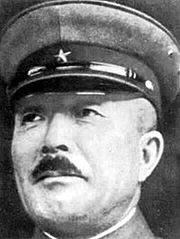![]() The Pacific War Online Encyclopedia
The Pacific War Online Encyclopedia
|
| Previous: Island Hopping | Table of Contents | Next: Itahana Giichi |

Itagaki Seishiro joined the Japanese
Army in 1904. During the 1930s he served in China,
where he worked closely with Ishihara Kanji to help stage the Mukden
Incident that led to
Japanese seizure of Manchuria.
At one point, Itagaki allowed a subordinate to threaten the
Japanese
Consulate-General with a sword when the latter insisted on trying
to
settle the incident through diplomatic
channels. Itagaki later helped instigate the First Shanghai Incident, in 1931.
Made commander of the elite 5 Division in 1937, Itagaki was ambushed and badly defeated by Communist guerrillas at Pingsinkuan in September 1937. He was serving as War Minister at the time of the Changkufeng Incident of July-August 1938, a border skirmish near the Manchuria-Russia-Korea junction that ended in stalemate. Itagaki was dressed down by the Emperor for escalating the fighting, and the Emperor insisted that not a single soldier was to be redeployed in the future without Imperial consent. However, Changkufeng was followed by the battle of Nomonhan in May-July 1939, where Japanese forces were badly mauled by the Russians. Disgraced by the defeat, and by his failure in secret negotiations with Chiang Kai-shek in August 1940 to end the China Incident on terms favorable to Japan, Itagaki was put in command of Korea Army, a backwater post, until April 1945, when he was sent to Malaya to command 7 Area Army. Here he unsuccessfully attempted to persuade Terauchi to refuse to submit to the Emperor's order to surrender (Allen 1984):
We are still unaware of His Majesty's real intentions. While this is so, should we not continue to fight with everything we have?
Itagaki also delayed informing his command of the Japanese capitulation for four days to allow time to destroy evidence of Japanese war crimes.
Itagaki was hanged as a war criminal for mistreatment of prisoners of war and internees while commander of 7 Area Army. One of the charges against him was that he requested that 2,000 Allied prisoners of war be sent to Korea so that they could be publicly humiliated for the purpose of improving civilian morale. In response, a thousand British and Australian prisoners were sent to Pusan from Singapore. One of the prisoners later testified that, after being robbed of watches and wedding rings by the Kempeitai,
... all the prisoners, including those who were sick, were made to fall in, in columns of four, and were marched round the streets of Fusan [Pusan] between the marshalled Korean inhabitants fo the city, with a Japanese officer at the head of the column on horseback and Japanese guards on either side. The march went on all day under a hot sun with only two halts in the playgrounds of two schools where the children were allowed to come close up to the prisoners to jeer and spit at them.
The prisoners were then transported to Seoul
where the performance was repeated.
Itagaki was reputed to be "a born organizer." However, he was also reputed to be not especially bright.
| 1885
|
Born |
|
| 1904 |
Commissioned an infantry officer |
|
| 1924 |
Military advisor, China |
|
| 1926 |
Army General Staff |
|
| 1927 |
Staff, 33 Brigade |
|
| 1927 |
Staff, 10 Division |
|
| 1928 |
Colonel
|
Commander, 33 Regiment |
| 1929 |
Staff, Kwantung Army |
|
| 1931 |
Major general |
Chief of Intelligence Section, Kwantung Army |
| 1932 |
Military advisor, Manchukuo |
|
| 1933 |
Army General Staff |
|
| 1934 |
Chief military advisor, Manchukuo | |
| 1934 |
Vice chief of staff, Kwantung Army | |
| 1936-3
|
Chief of staff, Kwantung Army | |
| 1936-4 |
Lieutenant
general |
|
| 1937-3 |
|
Commander, 5 Division |
| 1938 |
Army General Staff |
|
| 1938 |
Minister of War |
|
| 1939 |
Chief of staff, China
Expeditionary
Army |
|
| 1941 |
General |
Commander, Korea
Army |
| 1945-4
|
Commander, 7
Area Army |
|
| 1946 |
Arrested as war criminal |
|
| 1948-12-23
|
Condemned to death and hanged |
References
Generals.dk
(accessed
2007-11-13)
Russell (1958)
The Pacific War Online Encyclopedia © 2007-2011, 2015 by Kent G. Budge. Index